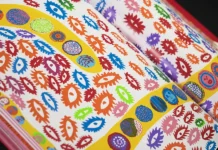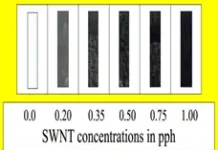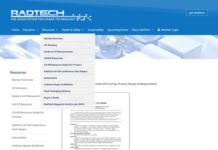By Mike Higgins, east regional sales manager, Phoseon

What is ultraviolet wavelength?
The sun is a source of the full spectrum of ultraviolet radiation, which is commonly subdivided into UV-A, UV-B and UV-C. Wavelength, a fundamental descriptor of electromagnetic energy, is the distance between corresponding points of a propagated wave. Typical UV light source emission wavelengths range from ultraviolet (UV-C: 100 to 280nm; UV-B: 280 to 315nm; UV-A: 315 to 400nm) to visible light (400 to 700nm) and infrared (700 to 3000nm).
UV wavelengths typically are measured in nanometers (nm). Nanometer, a unit of length, is equal to one billionth of a meter. UV light-emitting diodes (LEDs) have a narrow spectral output centered on a specific wavelength, +/- 15nm, with typical commercial UV-LED lamps emitting at 365nm, 385nm, 395nm or 405nm wavelengths.
The irradiance (W/cm2) produced by UV-LED light sources has increased consistently year over year because of advancements in both diode and lamp technology, and now is available at effective outputs higher than those offered by traditional UV curing lamp technologies. UV-LED lamp systems have enough power to conquer a wide range of applications and today are being used commercially to cure inks, coatings and adhesives. Today, UV-LED curing lamps offer peak irradiance up to 24W/cm2 (water-cooled) and 16W/cm2 (air-cooled) at 395nm, and that number will continue to increase. UV-LED systems at 365nm are available offering peak irradiance of 12W/cm2 (water-cooled) and 8W/cm2 (air-cooled).
Why are we limited to high UV-A wavelength?
Wavelengths emitted by UV-LED lamp systems are determined by the characteristics of the diodes selected in the lamp manufacturing process. UV-LEDs are manufactured by a handful of companies both domestic and international. Globally, demand for LED diodes is driven by automotive, general lighting, mobile device and signage applications. Despite higher profit margins on UV-LED diodes, market demand pales in comparison to larger, global market drivers such as general lighting and signage. While UV-B and UV-C diodes exist, they currently are limited by low power, an extremely short lifetime (~500 hours) and price points that can be 250 times the price of UV-A diodes.
As a result of high demand for UV-A diodes in the aforementioned markets, most UV-LED development work over the last 14 years has been focused on 365 to 405nm. Diode performance in this wavelength region is well understood and lifetime expectations exceed 20,000+ hours. It is important to note that long lifetimes are not a given. All UV-LED lamps are not created equal, and it is important to fully understand the specifications of a lamp system before making an investment. Continued price pressure on UV-LED is limiting the pursuit of shorter wavelength UV-LED systems. Therefore, it is safe to assume that 365 to 405nm will be the dominate market offering for UV-LED for the foreseeable future.
The photopolymerization process
Polymerization is a process in which small molecules are reacted chemically to form very large molecules and molecular networks called polymers. In the coatings, ink and adhesives industries, this process also is known as curing, drying or hardening and converts liquid formulations into a hard solid film or elastomeric solid with properties designed for the application. Photopolymerization utilizes the photons (UV or visible wavelengths) emitted by a lamp source to initiate the chemical reactions by excitation of special additives called photoinitiators. Upon absorption of the UV energy, the photoinitiator (PI) produces a highly reactive chemical species that initiates the reactions that tie the resinous components (oligomers, monomers, etc.) together (crosslinking) to cure or solidify the ink, coating or adhesive.
Formulating UV chemistries for UV-LED lamps
UV formulations for inks and coatings typically contain binders (oligomers, resins), diluents (monomers, water, or solvents), photoinitiators, and additives. Diluents are often necessary to reduce the viscosity of the formulation to enable application by spray, jetting, roll-coat, printing, or other techniques. Monomers can take the place of water or solvent for more environmentally friendly formulations, and serve to control viscosity while also being chemically incorporated into the resulting polymer network, reducing emissions and/or energy consumption compared to waterborne or solvent-borne formulations. The oligomers (and their backbone structure) determine the overall properties of the material. Monomers and oligomers in UV formulations are generally derivatives of acrylates or methacrylates containing polyurethanes, polyesters, polyethers or acrylic chemistries. Colorants such as pigments and dyes provide color and special effects, while silica, waxes, clays, and extenders are used to affect physical properties and sometimes to reduce the cost of formulations by replacing part of the more expensive binder components. Additives such as adhesion promotors, dispersants, flow-aides, degassing agents, UV stabilizers and others are used to improve specific properties of the formulations during the physical application process and after curing.
To achieve efficient and effective UV curing of an ink, coating or adhesive, the formulator seeks to match the UV lamp spectral output with the absorption characteristics of the photoinitiator(s) used in the formulation. The amount of PI in a typical UV formulation is usually very small, less than 5% by weight. PI’s typically absorb across a range of wavelengths, not a single narrow band, and most existing UV formulations developed for curing with a typical mercury-arc lamp use a broad-spectrum PI. While there is often some absorption within the UV-LED output range, it is clear that much of the conventional PI absorption range is not utilized when formulations are cured with a single-band UV-LED lamp. A more efficient cure is possible with a formulation designed specifically for UV-LED curing using a PI with high molar absorptivity in wavelength bands emitted by the UV-LED source. Since current-generation UV-LED emission wavelengths are strongest at 365nm and 395nm, photoinitiators and other formulation components should be selected to allow efficient excitation of the photoinitiator(s) at those wavelengths.
Depth of penetration into a coating, ink or adhesive formulation during curing depends on the absorptivity (optical density) of the formulation at each wavelength. The optical density at each wavelength is determined by the selection of the resin components, colorants and additives that compose the formulation. In UV formulations we find that UV-C wavelengths typically are absorbed in the surface layers due to high optical density of the resins and other formulation components at the shorter UV wavelengths, while UV-B and UV-A penetrate more deeply into the film even to the point where formula meets substrate. Thus, the formulator must not only match the absorbance bands of the photoinitiator to the UV emission wavelengths of the UV-LED lamp, but also must consider the absorption characteristics of the colorants (dyes, pigments), resins (monomers, oligomers, binders) and other additives in the formulation to avoid competitive absorption that can prevent the UV wavelengths from reaching the photoinitiator.
The longer wavelength output, such as the UV-A range emissions from current high-irradiance UV-LED systems, penetrates through thick and pigmented systems more easily than UV-B or UV-C wavelengths, producing through-cure of the material that typically improves adhesion and the ability to cure thicker screen ink or pigmented wood coatings. Shorter UV wavelengths (200 to 280 nm) are unable to penetrate very deeply into a material, but provide surface curing, which is important for properties such as scratch and chemical resistance. Tailoring the formulation composition to take advantage of the specific UV wavelengths emitted by the UV-LED source being used can significantly improve the depth of penetration and the degree of cure of a UV formulation in specific applications.
Irradiance and energy density
 The physical and chemical properties of a UV-cured formulation are significantly impacted by the degree of cure (extent of reaction or crosslinking) of the components in the formulation. The degree of cure may vary as a function of depth in the coating/ink and as a function of the curing conditions, and is often determined qualitatively by scratch, pencil hardness, or solvent resistance. Generally, the more photons absorbed by the photoinitiators in the formulation, the more chemical reactions and the higher degree of cure / crosslinking / etc. (Note, however, that more is not always better!) Energy density (slang term: dose) and irradiance (slang term: intensity) are two key parameters that help to characterize the curing conditions experienced by a UV formulation, and provide two specific variables that can be monitored and tweaked to optimize the overall properties and performance of the UV-cured material.
The physical and chemical properties of a UV-cured formulation are significantly impacted by the degree of cure (extent of reaction or crosslinking) of the components in the formulation. The degree of cure may vary as a function of depth in the coating/ink and as a function of the curing conditions, and is often determined qualitatively by scratch, pencil hardness, or solvent resistance. Generally, the more photons absorbed by the photoinitiators in the formulation, the more chemical reactions and the higher degree of cure / crosslinking / etc. (Note, however, that more is not always better!) Energy density (slang term: dose) and irradiance (slang term: intensity) are two key parameters that help to characterize the curing conditions experienced by a UV formulation, and provide two specific variables that can be monitored and tweaked to optimize the overall properties and performance of the UV-cured material.
In simplistic terms, irradiance is a measure of how “bright” the UV source is as observed by the surface of the formulation during curing. Also stated simply, energy density is a combination of how “bright” the UV source is and how long the formulation is exposed. More specifically, irradiance is the instantaneous number of photons at a specific wavelength or range of wavelengths striking the surface per unit area, and is expressed in watts per square centimeter. Peak irradiance is the maximum irradiance that the surface experiences during the curing process. Energy density is the time-integral of irradiance and represents the total sum of photons of a specific wavelength or wavelength range received by a specific area of the surface within a specific length of time. Energy density is typically expressed in units of Joules per square centimeter.
Measuring irradiance
What device should be used to measure the output from UV-LED lamps? Several manufacturers provide products to measure irradiance and energy density. The sensors used in most current radiometers have been characterized and calibrated to work with the output profiles of mercury lamps and have not fully accommodated the unique emission characteristics of UV-LED sources. Since UV-LEDs have a very different emission profile, the sensor calibration for a given wavelength band is the most important characteristic. A radiometer that crops or doesnt count all of the UV emission based on a normal LED wavelength tolerance can lead to measurement errors and should not be used to set irradiance specifications.
The spectral characteristics of UV-LED lamps are significantly different than those of traditional systems, and radiometers that will accurately measure UV-LED emissions are just coming onto the market. Even then, radiometers need to be calibrated for specific characteristics of LEDs from specific lamp manufacturers. A “generic” UV-LED radiometer that can be used with different UV-LED lamps does not currently exist. For process control, it is important for OEMs and end-users to utilize a UV-LED radiometer that is calibrated to the UV-LED lamp providers specifications. Otherwise, false readings and/or improper conclusions are the likely results.
Measuring irradiance is not a simple task. UV-LED lamp manufacturers, measurement device manufacturers, OEMs, and end-users should align around a single industry standard that can be used to consistently, accurately, and succinctly report irradiance and energy density measurements.
Conclusion
UV energy emitted from UV-LED lamps and UV energy emitted by conventional mercury arc lamps or microwave lamps is all in the form of photons of specific wavelengths. That is, for purposes of UV photopolymerization, photons are photons, with the only differences being in quantity and wavelength. The distribution of wavelengths emitted by UV-LED lamps is much narrower than the distribution of wavelengths emitted by conventional UV sources, and as a result, formulations and radiometers used with UV-LED lamp systems must be matched to the emission bands of the UV-LED lamp used in that curing system to achieve optimal performance.
UV-LED-based curing is now an accepted, user-friendly tool in printing, coatings and adhesive markets, and UV-LED system characteristics are enabling a number of applications that were impractical or limited by physical constraints of conventional UV sources. These industry users and UV-LED suppliers continue to challenge formulators and chemical raw material suppliers to develop and supply UV-LED wavelength-optimized materials and formulations. At the same time, UV-LED curing units have become more efficient in delivering UV energy to the media, thus driving not only environmentally clean, energy-efficient and compact-size units but also enabling increased throughput and process flexibility.
Mike Higgins is east regional sales manager for Phoseon Technology and a member of the Editorial Board for RadTech. After nine years with Sartomer, Higgins has spent the past three years supporting the rapidly growing LED market. Experience in both acrylate chemistry and next generation equipment has given him a unique perspective and understanding of the UV-curable marketplace, as well as insight into potential applications and future growth. For more information, email mike.higgins@phoseon.com or visit www.phoseon.com.






